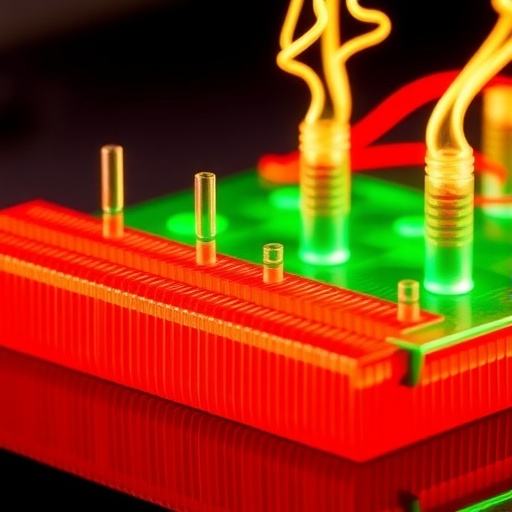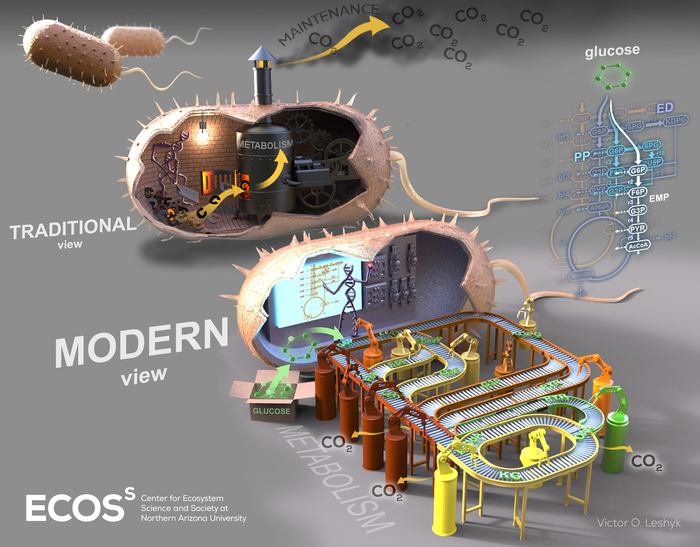In the quest to revolutionize water purification and sustainable chemical production, scientists have long grappled with the complex interplay of catalytic activity, selectivity, stability, and material costs. The challenge is particularly pronounced in electrochemical reactions, where the precise tuning of catalyst active sites often mandates compromises among these crucial parameters. However, a recent breakthrough in electrocatalysis provides a compelling new strategy that sidesteps these tradeoffs through an innovative approach involving selective adsorption within electrified membranes. This discovery promises to dramatically advance nitrate reduction technology – a pivotal process for environmental remediation and resource recovery – while leveraging inexpensive materials and scalable systems.
The implementation of this concept on a copper/carbon nanotube composite electrified membrane eliminates the need for precious metals, which are often critical yet costly components in high-performance electrocatalysis. Copper, widely regarded for its versatility and affordability, serves as the catalytic bedrock, while the carbon nanotubes contribute structural integrity and superior electrical conductivity. The ionophore functions as a complementary adsorption matrix, sequestering nitrite locally and facilitating its rapid subsequent reduction to ammonia. This cooperative mechanism suppresses the typically problematic nitrite accumulation, thus enhancing overall nitrate conversion and selectivity within mere seconds of treatment time.
.adsslot_1MTuoJOUSm{width:728px !important;height:90px !important;}
@media(max-width:1199px){ .adsslot_1MTuoJOUSm{width:468px !important;height:60px !important;}
}
@media(max-width:767px){ .adsslot_1MTuoJOUSm{width:320px !important;height:50px !important;}
}
ADVERTISEMENT
Such a quick transformation is remarkable given the complexity of nitrate reduction chemistry, which traditionally demands longer reaction intervals to achieve satisfactory conversion and selectivity. Here, a treatment time of just six seconds yielded nitrate conversion exceeding 94%, alongside ammonia selectivity surpassing 91%. The reduction in nitrite concentration to a negligible 1.1% underscores the system’s ability to guide the reaction pathway effectively without directly altering the intrinsic catalytic sites on the copper surface. This design philosophy — manipulating the local reaction environment rather than tampering with catalyst composition — heralds a new paradigm for fine-tuning electrochemical processes.
Beyond laboratory conditions, the approach demonstrated robust performance in treating real surface water and wastewater effluent, both of which typically contain low nitrate concentrations alongside complex matrices of interfering substances. The membrane’s stability and selectivity held steady over prolonged operation, all without resorting to rare or toxic metals. Such resilience is critically important for practical water purification technologies, where operational longevity and cost-effectiveness are essential for real-world deployment.
The integration of selective adsorption phenomena within an electrified membrane setting also represents a scalable solution with immediate industrial relevance. Conventional catalytic modifications often involve intricate synthetic routes and expensive nanostructuring techniques, impeding large-scale implementation. In contrast, the ionophore integration is relatively straightforward, relying on known ion-selective organic components incorporated during membrane fabrication. Coupled with the intrinsic benefits of membrane electrolysis — including continuous operation, ease of separation, and modularity — the system provides a versatile platform adaptable to diverse nitrate concentrations and water qualities.
This advancement transcends nitrate reduction, offering a broader conceptual framework for electrochemical reaction engineering. Selective adsorption components could be tailored to other reaction intermediates or target species, enabling precise control over multi-step catalytic processes without complex catalyst redesign. Such flexibility is anticipated to accelerate innovation in fields ranging from carbon dioxide valorization to pollutant degradation and fine chemical synthesis, where reaction selectivity drives efficiency and sustainability.
One critical aspect of this work is its emphasis on maintaining catalyst stability without sacrificing performance. The ionophore’s role is passive in terms of electron transfer yet active in shaping the chemical environment. By avoiding direct catalytic site modification, potential issues such as site poisoning, structural degradation, or altered electronic properties are minimized, extending catalyst lifespan. This strategy aligns well with sustainable manufacturing principles, targeting both circularity and environmental responsibility.
Furthermore, the use of carbon nanotubes in the membrane architecture delivers synergistic benefits. Their high surface area and conductive network facilitate rapid electron transport during electrolysis, while their mechanical robustness supports long-term structural integrity. The copper catalyst uniformly dispersed on this network maximizes active site availability. In such an optimized environment, the ionophore-enhanced nitrite enrichment ensures the electrocatalytic conversion proceeds with unprecedented speed and selectivity.
From a mechanistic standpoint, the ionophore’s role can be understood as establishing a local concentration gradient of nitrite near the electrocatalyst. This targeted enrichment not only reduces the diffusive losses of intermediate species but also enhances their probability of undergoing consecutive reduction steps. Preventing nitrite escape into the bulk solution curtails side reactions and mixed product formation, crucial for achieving high ammonia selectivity. This cooperative effect signals a shift from traditional ‘active site-centric’ catalysis to ‘microenvironment engineering’ in electrochemical systems.
In terms of environmental impact, transforming nitrate into ammonia within seconds presents significant advantages. Elevated nitrate levels in water bodies are detrimental to ecosystems and human health, causing issues like eutrophication and methemoglobinemia. Current remediation methods are often energy-intensive or generate hazardous byproducts. Electrochemical reduction powered by renewable electricity, especially using nonprecious metal catalysts, offers a cleaner alternative. Additionally, producing ammonia — a valuable chemical feedstock and fertilizer — from waste aligns with circular economy goals, upgrading pollutant liabilities into resource assets.
The researchers demonstrated that their ionophore-incorporated membrane could operate effectively across a range of nitrate concentrations, which is critical for versatility across various contamination scenarios. The membrane system’s modularity also permits integration into existing water treatment infrastructures or decentralized setups. Such adaptability heralds a new generation of smart, selective, and sustainable electrocatalytic devices poised for widespread societal impact.
This study also raises intriguing questions for future exploration. For instance, the design of ionophores with specificity for other important reaction intermediates could unlock new pathways for multi-electron/electron-proton transfer processes. The interplay between adsorption kinetics, membrane transport properties, and electrochemical driving forces offers fertile ground for theoretical and practical optimization. Moreover, coupling this selective adsorption strategy with emerging catalyst designs may further elevate performance metrics, pushing boundaries in efficiency, cost, and sustainability.
Overall, this work exemplifies the transformative potential of integrating molecular-level design into macroscopic membrane technologies. By focusing on cooperative adsorption within electrified membranes, the researchers chart a course toward cost-effective and scalable nitrate reduction solutions that deftly navigate long-standing challenges in electrocatalysis. Such innovation not only advances water treatment and resource recovery but also inspires a broader reevaluation of how reaction environments can be molecule-tailored to unlock new catalytic landscapes.
As this technology matures, its implications could ripple across environmental, agricultural, and chemical manufacturing sectors. The renewed emphasis on exploiting common materials like copper, alongside straightforward but strategic membrane functionalization, may democratize access to advanced electrochemical processes worldwide. Ultimately, harnessing selective adsorption in electrified membranes presents a powerful new lever for controlling the fate of reaction intermediates, driving sustainable chemical transformations with precision and practicality.
By bridging the gap between molecule-level interactions and engineering-scale devices, the work reported here opens exciting vistas for electrocatalytic science and technology. The potential to finely tune reaction pathways without resorting to costly or fragile catalytic materials aligns squarely with global priorities for sustainable development, clean energy, and environmental stewardship. This breakthrough stands as a testament to how thoughtful integration of chemistry, materials science, and process engineering can forge innovative solutions to pressing challenges of the twenty-first century.
Subject of Research: Electrochemical nitrate reduction via selective adsorption in electrified membranes.
Article Title: Tuning nitrate reduction reaction selectivity via selective adsorption in electrified membranes.
Article References:
Fan, Y., Yan, Y., Nwokonkwo, O. et al. Tuning nitrate reduction reaction selectivity via selective adsorption in electrified membranes. Nat Chem Eng (2025). https://doi.org/10.1038/s44286-025-00237-3
Image Credits: AI Generated
Tags: catalyst active site tuningelectrified membranes in water purificationelectrocatalysis breakthroughselectrochemical reactions for environmental remediationhigh-affinity ionophores in catalysisinnovative membrane technologiesnitrate reduction technologynitrite-adsorbing ionophoresovercoming electrochemical reaction challengesresource recovery processesselective adsorption in membranessustainable chemical production methods






